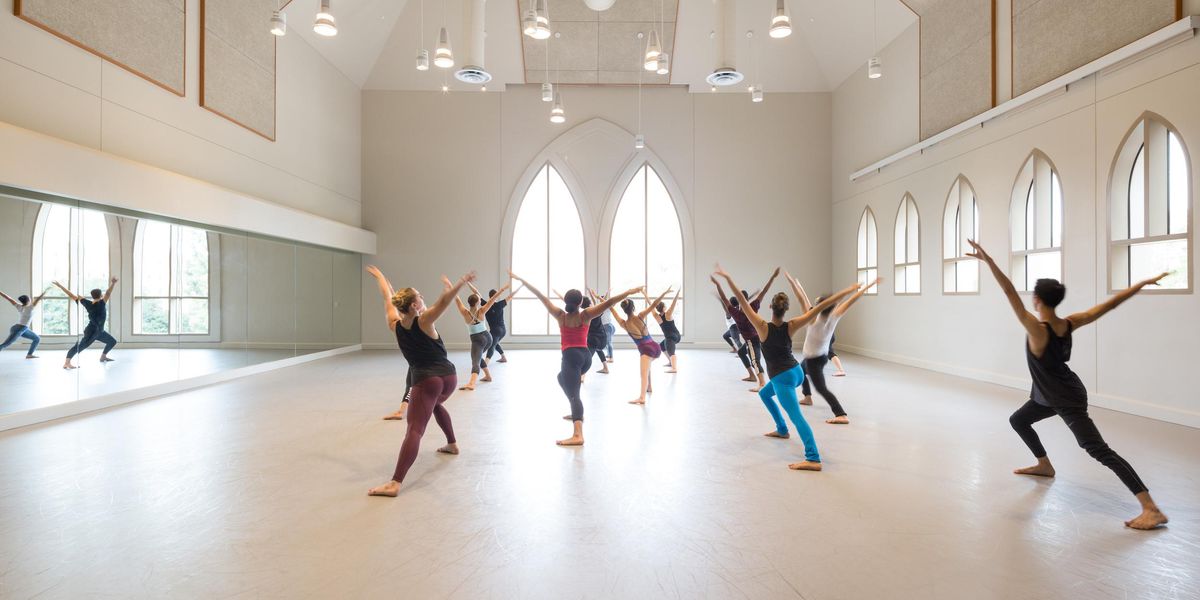ABT of the West?
BSJ in Jorma Elo’s
Glow-Stop
In the century-old Knights of Columbus Hall in downtown San Jose, California,
the plaintive melody of Ástor Piazzolla’s bandoneon rises to the rafters of a high-ceilinged ballroom. A century ago the Knights held dances here; today it’s a sunny studio where Ballet San Jose is rehearsing Paul Taylor’s Piazzolla Caldera. “Twist from the tendu all the way through the head,” says répétiteur Richard Chen See. “More of a Latin feel. The style of the piece is pulled up and forward.” His directive reflects the exacting demands of Taylor’s choreography, which combines contemporary freedom with a precise, linear structure. But the push toward greater technicality and deeper artistry also reflects BSJ’s redefined standards—set by revamped leadership that includes new artistic director José Manuel Carreño—that are intended to transform the long-troubled company into a regional, and perhaps national, force in the dance world.
The company was set adrift in 2011, when the dramatic ouster of its then artistic director, Dennis Nahat, left a vacuum in leadership and creative vision. Nahat had founded the company in 1985 as the San Jose Cleveland Ballet, a dual-residency troupe that ultimately morphed into BSJ, and over the years became a beloved figure in Bay Area dance, avoiding territorial struggles with San Francisco Ballet 45 miles to the north.
The trouble began when the dot-com bust of the early 2000s devastated BSJ’s finances. The company stayed afloat with loans and major gifts from then-board chairman John Fry; unconfirmed estimates of Fry’s largesse range from $14 million to upwards of $20 million. The influx of cash allowed the company to continue to mount full-lengths such as Swan Lake, plus mixed-rep performances that included works by Balanchine, Jessica Lang and Tudor, a repertoire that showed exemplary taste yet lacked contemporary freshness; critics recognized standout principals like Karen Gabay and Alexsandra Meijer, but hinted that the company’s ambitions outmatched its execution. Reports at the time suggested that Fry wielded influence over the repertoire, board and company, exacerbating in-fighting. Things came to a head in January 2012, when Fry resigned from the board and Nahat received a letter of dismissal. Wes Chapman (formerly head of ABT II) helmed the company as artistic advisor in the interim, and Carreño took the reins last September with his blessing.
Executive Director Stephanie Ziesel, who joined the company in 2009, acknowledges that “from every facet and on every level, it was a very fragmented organization.” She seems to have emerged from the tumultuous transition with a deeper commitment to not only reviving the company, but to taking it to a place of prominence. Bringing on like-minded people such as Carreño, and making strategic internal promotions, has resulted in a unified vision. “It’s a rare opportunity for any company to kind of be in this clean-slate mode, where it’s a collaboration,” Ziesel says. “Not just between the artistic and administrative staff, but also with the board and every aspect of leadership.”
José Manuel Carreño gives company class
Ziesel herself has American Ballet Theatre connections; she is the sister of Mary Jo Ziesel, ABT’s director of education and training. In 2011, the two companies formed a “strategic relationship” that grants BSJ access to ABT’s repertoire, sets and costumes, as well as virtual letters of introduction to directors, artists and choreographers whose work BSJ might want to license. The connection was another lifeline that helped BSJ weather the stormy years. In addition, the BSJ School adopted ABT’s training syllabus, and is currently the only West Coast school certified to teach the ABT Curriculum. It will also participate in Project Plié, an ABT initiative to increase cultural diversity in ballet, starting at the school level. The school is expected to become a destination for pre-professional students, as well as a feeder for BSJ.
The June 2013 announcement of Carreño’s appointment brought BSJ instant media exposure and piqued the curiosity of balletomanes from coast to coast. His appeal is obvious: impeccable ballet credentials, masterful teaching skills and brand-name recognition around the world, not to mention an easygoing, approachable personality. But with little management experience beyond running his festival, can he revive a struggling ballet company? Is he prepared to handle tedious logistics, work within a budget and, perhaps hardest of all, manage 36 ambitious dancers and apprentices? “I love challenge,” he said in an interview in September 2013, just three weeks after he started.
Ommi Pipit-Suksun and BSJ members in company class
Retired from an illustrious dance career with ABT, The Royal Ballet and English National Ballet, the Cuban-born Carreño, 45, was not seeking an artistic directorship. Since his 2011 retirement he has focused on guest performances and on producing the Carreño Dance Festival, held each summer in Sarasota, Florida (he will continue to run the festival during BSJ’s off-season). Unlike the majority of his colleagues, he has no interest in creating choreography. The seeds of Carreño’s newest role were actually sown by chance a year ago, when he subbed for an injured dancer as Basilio in BSJ’s Don Quixote. “Meeting him and seeing his interaction with the dancers and how they took to him, it became a very natural process to start investigating whether this could work,” Ziesel recalls.
The newly positive atmosphere and lofty goals, combined with Carreño’s high profile, have attracted well-connected, well-heeled benefactors from Silicon Valley. “They see the change, and they want to be involved with it from the ground up,” says associate artistic director Raymond Rodriguez, who has been with the company since its beginning. For example, Seagate Technology CEO Stephen J. Luczo and his wife, Agatha, underwrote Carreño’s three-year contract. Donations are up considerably from the 2011–12 fiscal year, when contributed income dropped by 50 percent from the previous year, to under $2.5 million, and the company operated at a loss of over $1 million. For 2012–13, contributed income rose to $3.7 million, total revenue exceeded $5.5 million and the company nearly broke even. Ziesel predicts a balanced budget for this year of $5.8 million in total revenue, including a 25 percent increase in earned income from the previous year.
When asked if ABT plays any part in BSJ’s business or creative decisions, Ziesel asserts that her company is fully independent, and that her artistic director calls his own shots. “The only formal, defining documents are with respect to the ABT National Training Curriculum that we have implemented in our school,” she says.
Nonetheless, solid connections probably helped Carreño pull together BSJ’s high-octane 2013–14 season. His first coup was organizing a November fundraising gala featuring ABT’s Julie Kent and Misty Copeland, New York City Ballet’s Joaquin De Luz and Maria Kowroski, and SFB’s Maria Kochetkova, among others—a rare lineup for Bay Area audiences. It’s a testament to the goodwill Carreño enjoys that he could marshal that kind of star power on short notice.
Carreño worked similar magic to conjure up the 2014 repertory, a sophisticated offering replete with big names: Balanchine’s Serenade, Jorma Elo’s Glow-Stop and Roland Petit’s Carmen were already in BSJ’s rep, but the season boasts seven company premieres, including Ohad Naharin’s Minus 16, Twyla Tharp’s In the Upper Room and Taylor’s Piazzolla Caldera. Carreño’s choices suggest the versatility and quality he wants from his dancers, but also a savvy about the direction ballet is taking. “I said to Stephanie, ‘We have to start doing whatever we haven’t been able to do.’ That’s our goal now—going to a better rep, a more international rep, start touring with the company. That’s all my vision,” he said. Carreño’s wide-ranging connections helped him get permissions to license the pieces, and the improved budget meant the company could afford to pay for them.
The company roster is evolving to meet the elevated artistic and technical demands. One dancer opted not to return for the 2013–14 season and eight others were not renewed. For the future, Carreño wants versatile dancers who are hungry to grow. “My main thing with the dancers is to be in shape, taking class every day, working on yourself,” he says. “And from there, if you really have this open mind that you want to learn everything, you can change.” Passionate about teaching and coaching, he is dedicated to developing them to their greatest potential.
Among the current members are five principals, including longtime dancers Meijer and Ramon Moreno, plus the newly promoted Ommi (Nutnaree) Pipit-Suksun. Carreño has also stocked the corps with talented newcomers who are sure to rise: Joining the men are former Ballet Nacional de Cuba dancers Ihosvany Rodriguez and Walter Garcia. Rounding out the women’s corps are Grace-Anne Powers, most recently of Montreal’s La La La Human Steps, plus former ABT II dancer Alison Stroming.
And when the curtain rises on the February 14 season opening, it will be up to the dancers to deliver on the promise of the new BSJ. Carreño’s presence has given the company a glamorous jump-start, but along with that comes high expectations and close scrutiny of every trip-up and triumph as the company finds its way. Here’s hoping everyone at BSJ loves a challenge as much as José Manuel Carreño does.
Claudia Bauer is a dance writer based in the Bay Area.
Photos by Alejandro Gomez, Courtesy BSJ





